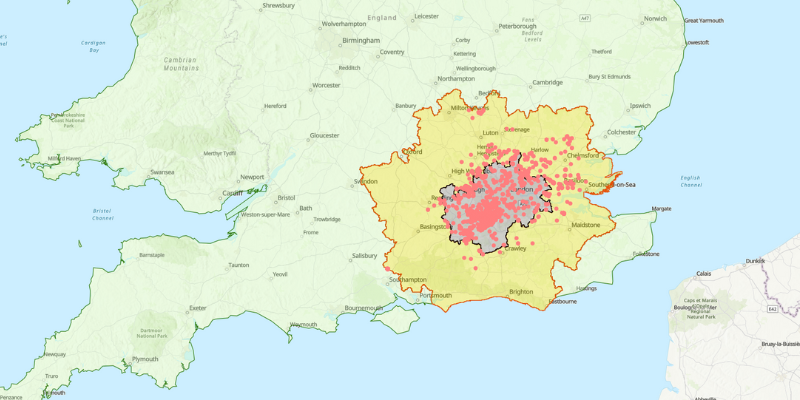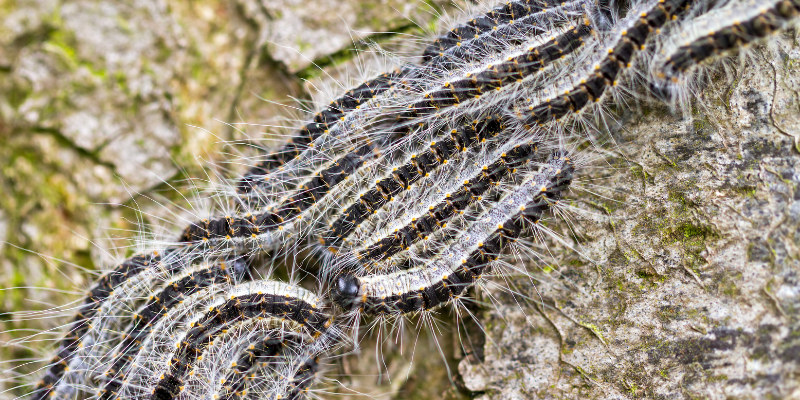Oak Processionary Caterpillars
Oak Processionary Moths (OPM) are undistinctive brown moths which are difficult to accurately identify because they are similar to a number of species. And really, there isn’t much to say about them. The issue with the OPM comes at caterpillar stage.
Wriggly, hairy and weirdly organised columns of caterpillars are quite an alien sight to behold. These are the signs that a battalion of OPM has arrived on the scene. But what are these unusual creatures and what risks do they pose to people and the environment?
In this post we’re going to tell you the key facts, how to identify the OPM and why it’s important that this invasive species should be controlled.
What is the Oak Processionary Moth?
The Oak Processionary is a moth who’s caterpillars can be found in oak forests. Originally native to Europe, the species was accidentally introduced into the UK in 2005 when some eggs in the canopy of trees that were imported for planting arrived.
Today the OPM is subject to a government-led programme of survey and control. OPM caterpillars live and feed almost exclusively on oak leaves where their voracious appetite can deal tremendous damage to the tree.
Currently the OPM is established in a relatively small geographical area, making its home across London and some surrounding areas. While slowed by control measures, the invasion continues to spread with each passing year.
As a result, more people are going to come into contact with this interesting and dangerous species.

When it comes to OPM management, there are three ‘zones’ or ‘areas’ to be considered. Each zone has a different level of requirements and level of control.
The zones are:
- Pest Free Area – Free from OPM, but surveillance and monitoring is undertaken with robust action on sighting.
- Buffer Area – Extensive programme to detect and treat OPM infested trees
- Established Area – OPM is established in this area and landowners are responsible for management
Landowners are responsible
In the established area if OPM is infesting oak trees on your land, then it’s your responsibility to manage it. This is where professionals (like us) come in. Due to the hazards and risks of contact with OPM (which we’re getting onto below!) it is strongly advised that you contract a professional to treat the infestation and remove any hazardous nest material from the area.
There are currently two pilot support schemes for people in the established area who may be able to get help with the costs of treatment:
- Private residents grant
- OPM Groups Grant
In the buffer zone, you may be issued with a Statutory Plant Health Notice (SPHN) which will direct you to take action against the infestation. In most cases, you will be able to get support from the government for treatment of infested oak trees that are in the buffer zone, but at the end of the day – you are responsible for ensuring that the infestation is treated.
Special Regulations
There are also special regulations on the movements of Oak materials (such as cut branches) that are the results of tree works and to the handling of OPM-affected materials. These regulations limit the movement of materials outside of the effected area. For example, Oak materials smaller than 10cm in diameter, which is the material most likely to harbour OPM eggs, must not be moved outside of the OPM-affected area.
In addition to the regulations on the movement of oak materials, there are also various restrictions on the trade and movement of Oak trees to help protect the country against OPM through movement and imports. This level of bio-security shows just how serious the risk of OPM could be if not strictly controlled.
The Dangers of the Oak Processionary Moth
Alright. Now we get down to the topic of why this species is such a nasty pest.
There are two main dangers that OPM poses. The first and most obvious is to the environment. The second is the risk to people and animals that come contact with the critters or their nests!
Threat to the environment
The OPM has an insatiable appetite. From the moment these creatures are born they want to eat. They will completely strip entire areas of oak trees of their leaves – a process known as defoliating. This damages the tree, leaving it vulnerable to other threats such as diseases, other pests and environmental stresses such as drought. Additionally, many native species in the UK make their homes in the trees and branches of the mighty oak. As the OPM eats their way through the canopy many species lose their habitat which puts a strain on biodiversity.

Threat to people and animals
According to forestry research, as the caterpillars grow they develop tiny hairs that contain an irritating protein called thaumetopoein. Coming into contact with these hairs can cause a range of unpleasant issues including the Oak Processionary Moth rash:
- Itching and inflamed skin
- Rashes
- Eye irritation
- Sore throat
- Breathing difficulties
The threat is most prevalent during the months of May and June as the caterpillars are reaching maturity. The caterpillars can shed their hairs when they feel threatened and when they’re disturbed. Their nests also accumulate a lot of the hairs, which can potentially fall to the ground, appearing as harmless leaf litter. In areas affected by the OPM caterpillar it’s possible to find the hairs stuck to trunk branches, in grass around the area and the hairs can get stuck on clothing and equipment.
The most ‘at risk’ of suffering from the OPM caterpillar tend to be:
- Children who may be curious and unknowing of the risks
- Curious pets that may want to investigate can suffer considerable distress from hairs in their mouths and noses, especially if they get into a fallen nest
- Those working with oak trees
- People spending time close to infested trees
- Grazing animals and livestock with oak trees nearby
How to identify the Oak Processionary Moth
Though it is possible to mistake some perfectly harmless species of caterpillar for OPM, the Oak Processionary Moth have distinguishing characteristics that will help you to identify them.
- OPM have a habit of moving around in the late spring and early summer months.
- They move in ‘nose-to-tail’ procession formations (processionary) that tend to be arrow-headed with 1 leader and then their followers behind in rows.
- They are very picky creatures and live almost exclusively on Oak and you can sometimes see making a procession from one tree to the next.
- They cluster together while feeding on oak leaves or when they’re moving.
- OPM is normally only seen during the months of May, June and July while they’re feeding.
- They have a grey body and dark head with the older larvae having a central dark stripe with pale lines down their sides.
- They have very long white hairs – these aren’t the ones that cause irritation, though. The hairs that cause irritation are tiny and almost undetectable.
If you aren’t sure if you’ve come across the OPM or one of the completely harmless other hairy caterpillars that live across the UK, then the best thing you can do is use our free identification service and we can quickly tell you if it’s OPM or not.

How can you protect yourself form OPM?
As you know by now, it’s not a wise idea to mess with the OPM yourself. But what should you do if you come into contact with it?
Here are a few common-sense steps that you can take to protect yourself from OPM:
- Keep away from the caterpillars and nests or you may end up being affected by those super fine hairs.
- Teach children to keep away from unknown caterpillars and insects.
- If you’re in areas that may be affected be sure to keep a close eye on your pet and keep them away from caterpillars and fallen nests.
- Do not attempt to remove the nest or the caterpillar yourself. OPM infestations need to be treated properly and seriously.
- Use our free identification service to determine if it is OPM
- Get help from professionals to deal with the infestation.
What to do if exposed
According to advice from the Government and the Forestry Commission, if you’re exposed to OPM and you’re showing any of the symptoms that we discussed you should:
- See a pharmacist if you need relief from skin or eye irritation following possible OPM contact.
- See a GP or consult NHS 111 if you have a serious allergic reaction
- Contact a vet if your pet has been affected
Wrapping it up!
So there you have it all the information you need to know about this alien invasion. If you’re worried about OPM or any other invasive species on or around your property, then get in touch with us and we’ll be more than happy to help.


